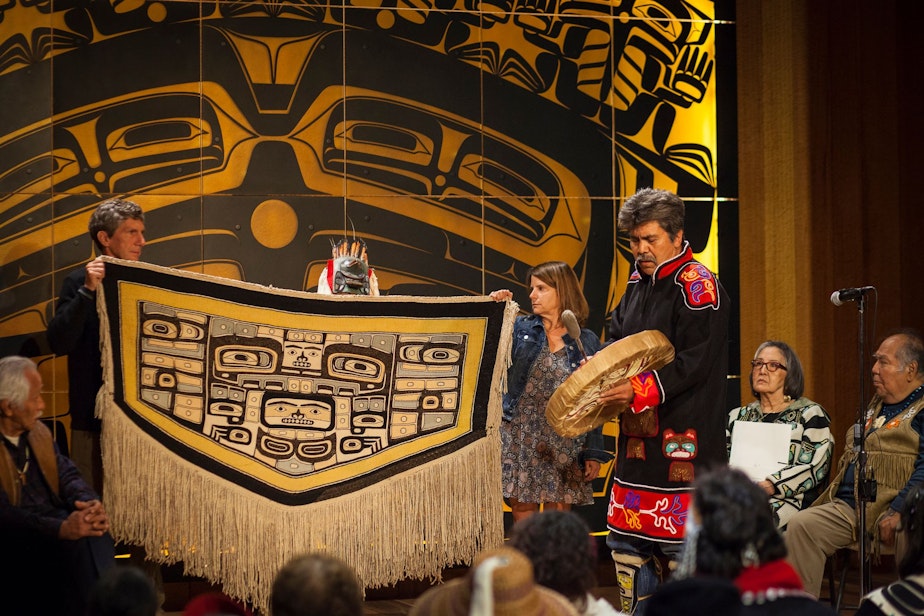Does your Native American artwork belong to you — or to its tribe?

When Bruce Jacobsen moved to Seattle in 1986, he fell in love with the Pacific Northwest. He wanted to express his appreciation with a piece of Native art, and found one at a gallery Pioneer Square: an antique Chilkat robe.
"I just thought it was so beautiful, and it was like nothing I had seen before," Jacobsen said.
Chilkat robes - or blankets, as they're also known - are woven by the Tlingit, Haida and Tsimshian peoples of Alaska and British Columbia and are traditionally made from mountain goat wool. The tribal or clan origin of this 6-foot-long piece was unclear, but it dated back to around 1900 and was beautifully preserved down to its long fringe.
"It's a completely symmetric pattern of geometric shapes, and also shapes that come from the culture," like birds, Jacobsen said. "And then it's just perfectly made - you can see no seams in it at all.”
Jacobsen bought the robe and hung it on his dining room wall.
Sponsored
His 19-year-old daughter, Sara, grew up eating family dinners beneath the Chilkat robe. She never thought much about it until her senior year of high school, when she saw a picture of a strikingly similar robe in an art history class.
The teacher told the class about how the robe was used in spiritual ceremonies, Sara Jacobsen said. "And I started to wonder why we have it in our house when we’re not Native American."
She said she asked her dad a few questions.
Bruce Jacobsen called that an understatement.
"I felt like I was on the wrong side of a protest rally, with terms like 'cultural appropriation' and 'sacred ceremonial robes' and 'completely inappropriate,' and terms like that," he said.
Sponsored
"I got defensive at first, of course. I was like, 'c’mon, Sara! This is more of the political stuff you all say these days.'"
But Sara didn't back down. "I feel like in our country there are so many things that white people have taken that are not theirs, and I didn’t want to continue that pattern in our family," she said.
Her father finally decided to investigate her claims. He emailed experts at the Burke Museum, which has a huge collection of Native American art and artifacts.
"I got this eloquent email back that said 'we’re not gonna tell you what to go do,' but then they confirmed what Sara said: that it was an important ceremonial piece, that it was usually owned by an entire clan, that it would be passed down generation to generation, and that it had a ton of cultural significance to them."
Jacobsen says he was a bit disappointed to learn that his daughter was right about his beloved Chilkat robe. But he and his wife, Gretchen, now no longer thought of the robe as theirs. Bruce Jacobsen asked the curators at the Burke Museum for suggestions of institutions that would do the Chilkat robe justice. They told him about the Sealaska Heritage Institute in Juneau.
Sponsored
When Jacobsen emailed, SHI Executive Director Rosita Worl couldn't believe the offer. "I was stunned. I was shocked. I was in awe. And I was so grateful to the Jacobsen family.”
Worl said the robe has a huge monetary value. But that's not why it’s precious to local tribes.
"It’s what we call 'atoow': a sacred clan object," she said. "Our beliefs are that it is imbued with the spirit of not only the craft itself, but also of our ancestors. We use [Chilkat robes] in our ceremonies when we are paying respect to our elders. And also it unites us as a people."
Since the Jacobsens returned the robe to the institute, Worl said, master weavers have been examining it and marveling at the handiwork. Chilkat robes can take a year to make – and hardly anyone still weaves them.
"Our master artist, Delores Churchill, said it was absolutely a spectacular robe. The circles were absolutely perfect. So it does have that importance to us that it could also be used by our younger weavers to study the art form itself."
Sponsored
Worl said private collectors hardly ever return anything to her organization. The federal Native American Graves Protection and Repatriation Act requires museums and other institutions that receive federal funding to repatriate significant cultural relics to Native tribes. But no such law exists for private collectors.
Worl says the institute is lobbying Congress to improve the chances of getting more artifacts repatriated. "We are working on a better tax credit system that would benefit collectors so that they could be compensated," she said.
Worl hopes stories like this will encourage people to look differently at the Native art and artifacts they possess.
The Sealaska Heritage Institute welcomed home the Chilkat robe in a two-hour ceremony over the weekend. Bruce and Gretchen Jacobsen traveled to Juneau to celebrate the robe's homecoming.
Do you have Native art or artifacts that you suspect may be significant to their tribe of origin? Try the Burke Museum's Object Identification Request Form to learn more about what you have - and which tribe might be its rightful owner.

